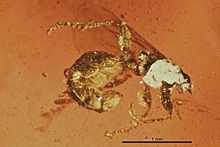Burmomyrma
| Burmomyrma Temporal range:
| |
|---|---|

| |
| Burmomyrma rossiholotype | |
| Scientific classification | |
| Domain: | Eukaryota |
| Kingdom: | Animalia |
| Phylum: | Arthropoda |
| Class: | Insecta |
| Order: | Hymenoptera |
| Genus: | †Burmomyrma Dlussky, 1996 |
| Species: | †B. rossi
|
| Binomial name | |
| †Burmomyrma rossi Dlussky, 1996
| |
Burmomyrmais anextinctgenusofaculeatehymenopteran, suggested to be an ant. The genus contains a single described species,Burmomyrma rossi.Burmomyrmais known from a singleMiddle Cretaceousfossil which was found inAsia.[1]
History and classification[edit]
Burmomyrmais known from a solitary adult fossil, theholotype,specimen number BMNH 19125. While the type specimen was collected in the early 1900s and deposited in theNatural History Museumin London, description of the specimen did not occur until nearly 80 years later.[1]The holotype specimen is composed of a mostly complete adult female which has been preserved as aninclusionin transparent chunks of deep yellow and relatively clearBurmese amber.Theamberspecimen was recovered from deposits inKachin Stateof Myanmar. Burmese amber has beenradiometrically datedusingU-Pbisotopes, yielding an age of approximately 99 million years old, close to theAptian–Cenomanianboundary.[2]
The fossil was first studied by Russian paleoentomologist Gennady M. Dlussky of theMoscow State University.Dlussky's 1996type descriptionof the new genus and species was published in thePaleontological Journal.[1]The genus nameBurmomyrmais a combination ofBurma,where the fossil was found, and theGreekmyrmicawhich means "ant". Thespecific epithetrossiis apatronymhonoring British paleoentomologist Andrew J. Ross.[1]The structures of the waist and wings lead Dlussky to tentatively placeBurmomyrmain the subfamily Aneuretinae. Due to the incomplete nature of the fossil, the genus has not been assigned to either of the aneuretine tribes, being leftincertae sedis.[1]This placement had been followed by other authors, including in the 2003 family review by entomologist Barry Bolton.[3]In a 2015 review of formicids, Brendon Boudinot noted that the features Dlussky listed for the inclusion ofBurmomyrmain Aneuretinae arepleisiomorphic,being found in several ant subfamilies, and that placement of the genus into several other subfamilies is possible. However Boudinot did not make any taxonomic moves in the review, leaving the Aneuretinae placement stand at that time.[4]In 2018 a revision suggested that the genus was not an ant, but was an ant-mimic wasp in the family Falsiformicidae with two other genera known from theTaimyr amber.[5]However, other studies have disputed this claim, finding that again instead it was an ant, but the highly fragmentary remains made its precise position uncertain.[6][7]
Description[edit]
The solitaryBurmomyrmaspecimen is incomplete and shows poor preservation in general with the antennae, head, and part of the thorax missing from the edge of the amber.[1]Overall it is estimated the full female body would have been around 3.0 millimetres (0.12 in) long with a thorax of about 1.0 millimetre (0.039 in). Thegasteris unconstricted, showing articulation between the first and second segments, and the first segments sports a number of short erect hairs. The sting has a distinct slight upward curvature and is overall short. The waist is composed of a single segment, composed of a nodiformpetioleshowing a cylindrical frontal area and narrowed posterior area. Theforewingvenation shows a lack of closed cells formed by veins. The petiol and forewings are distinguishing characters.[1]
References[edit]
- ^abcdefgDlussky, G. M. (1996)."Ants (Hymenoptera: Formicidae) from Burmese amber"(PDF).Paleontological Journal.30(4): 449–454.
- ^Barden, P.; Grimaldi, D. (2012)."Rediscovery of the bizarre Cretaceous antHaidomyrmexDlussky (Hymenoptera: Formicidae), with two new species "(PDF).American Museum Novitates(3755): 1–16.doi:10.1206/3755.2.hdl:2246/6368.S2CID83598305.
- ^Bolton, B. (2003). "Synopsis and classification of Formicidae".Memoirs of the American Entomological Institute.71:1–370.
- ^Boudinot, BE (2015)."Contributions to the knowledge of Formicidae (Hymenoptera, Aculeata): a new diagnosis of the family, the first global male-based key to subfamilies, and a treatment of early branching lineages".European Journal of Taxonomy(120): 50.doi:10.5852/ejt.2015.120.
- ^Lucena, D. A. A.; Melo, G A. R. (2018). "Chrysidid wasps (Hymenoptera: Chrysididae) from Cretaceous Burmese amber: Phylogenetic affinities and classification".Cretaceous Research.89:279–291.doi:10.1016/j.cretres.2018.03.018.ISSN0195-6671.S2CID134822731.
- ^Boudinot, Brendon E.; Perrichot, Vincent; Chaul, Júlio C. M. (2020-12-18)."†Camelosphecia gen. nov., lost ant-wasp intermediates from the mid-Cretaceous (Hymenoptera, Formicoidea)".ZooKeys(1005): 21–55.doi:10.3897/zookeys.1005.57629.ISSN1313-2970.PMC7762752.PMID33390754.
- ^Boudinot, Brendon E.; Khouri, Ziad; Richter, Adrian; Griebenow, Zachary H.; van de Kamp, Thomas; Perrichot, Vincent; Barden, Phillip (25 February 2022). "Evolution and systematics of the Aculeata and kin (Hymenoptera), with emphasis on the ants (Formicoidea: †@@@idae fam. nov., Formicidae)".bioRxiv.doi:10.1101/2022.02.20.480183.S2CID247146843.
External links[edit]
 Media related toBurmomyrma rossiat Wikimedia Commons
Media related toBurmomyrma rossiat Wikimedia Commons
